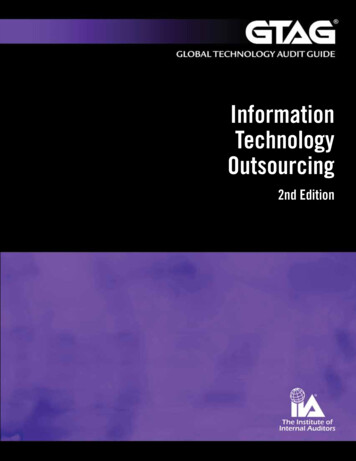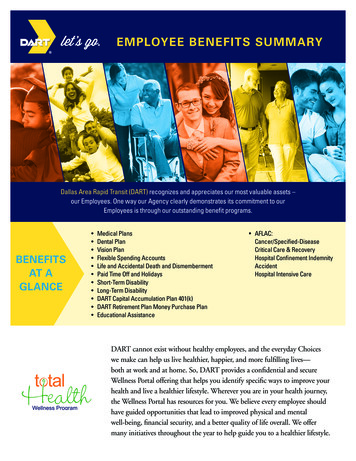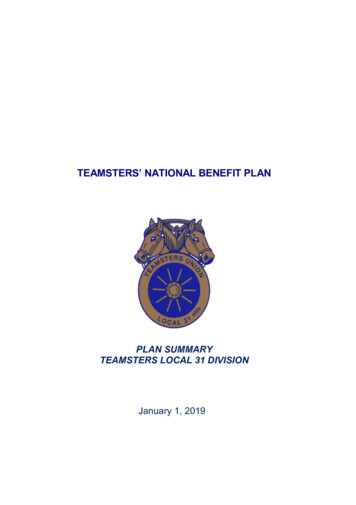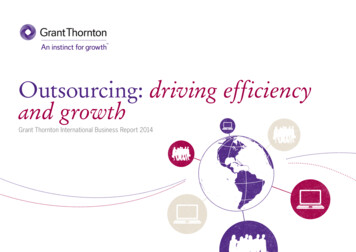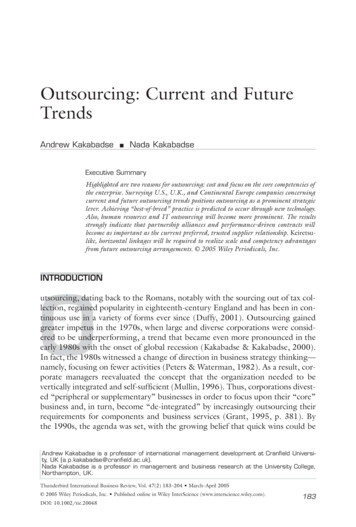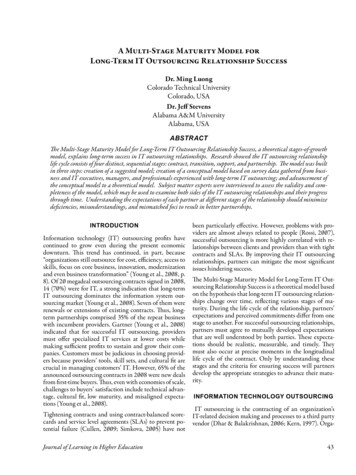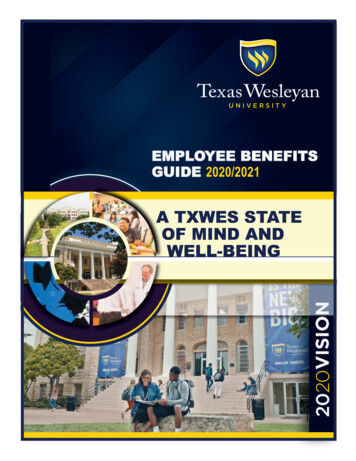
Transcription
Report to the Honorable Thomas E. Perez,United States Secretary of LaborOutsourcingEmployee Benefit PlanServicesNovember 2014
NOTICEThis report was produced by the Advisory Council on Employee Welfare and Pension BenefitPlans, usually referred to as the ERISA Advisory Council (the "Council"). The Council wasestablished under Section 512 of ERISA to advise the Secretary of Labor on matters related toWelfare and Pension Benefit Plans. This report examines Outsourcing Employee Benefit PlanServices. The contents of this report do not represent the position of the Department of Labor.LIST OF COUNCIL MEMBERSNeal S. Schelberg, Council ChairPaul M. Secunda, Council Vice ChairRalph C. Derbyshire, Issue ChairDavid C. Kaleda, Issue Vice ChairCindy Hounsell, Drafting Team MemberDeborah L. Smith, Drafting Team MemberJosh CohenChristina R. CutlipJames EnglishRon GebhardtsbauerKevin T. HanneyChristine S. HwangDennis F. MahoneyMark E. SchmidtkeJames I. Singeri
ABSTRACTThe 2014 ERISA Advisory Council examined the outsourcing of employee benefit plan serviceswith a particular focus on functions that historically have been handled by employers, such as“named fiduciary” responsibilities. The Council also looked at multiple employer plans or“MEPs” and their potential role in the outsourcing industry. Through its examination, theCouncil’s intent was to identify areas in which the Department could provide education,outreach, regulatory guidance, and sub-regulatory guidance pertaining to employer’s outsourcingof employee benefit plan services. Further, the Council hopes that employers will find its reporthelpful in understanding outsourcing practices and their underlying legal obligations under theEmployee Retirement Income Security Act of 1974.ii
ACKNOWLEDGEMENTSThe Council recognizes the following individuals and organizations who contributed greatly tothe Council’s deliberations and final report. Notwithstanding their contributions, any errors inthe report rest with the Council alone.Written Submissions & Oral Testimony:Brian GolobRussell InvestmentsSamuel HalpernGallagher Fiduciary AdvisorsAllison KlausnerHoneywell, for American Benefits CouncilColleen MedillUniversity of Nebraska College of LawMargaret RaymondT. Rowe Price AssociatesNorman SteinPension Rights CenterSanford WaltersKelly and Associates Insurance Group, for the Society ofProfessional Benefit Administrators (SPBA)Lou CampagnaEBSAKristen SteffensRV KuhnsBrian SmithSegal Select Insurance ServicesPete SwisherPentegra Retirement ServicesTerry PowerPlatinum 401(k)Troy TisueTAG ResourcesNorman SteinPension Rights CenterAliya WongU.S. Chamber of CommerceWritten Submissions Only:Patrick J. ClearyNational Association of Professional EmployerOrganizations (NAPEO)James Szostek and Shannon Salinas American Council of Life Insurers (ACLI)Heath Miller and Al OttoShepherd Kaplan LLCCharles G. HumphreyFiduciary Plan Governance, LLCTransamerica Retirement Solutions Corporationiii
TABLE OF CONTENTSI.II.III.IV.EXECUTIVE SUMMARY RECOMMENDATIONS SUMMARY OF TESTIMONY AND COUNCIL DISCUSSION A. Current Practices in Outsourcing .B. Legal Framework for Outsourcing under ERISA .C. Duty to Select and Monitor Service Providers D. Multiple Employer Plans and Similar Arrangements .E. Bonding and Liability Insurance Practices .CONCLUSION .iv1234814182223
Outsourcing Employee Benefit Plan ServicesI.EXECUTIVE SUMMARYThe 2014 ERISA Advisory Council (the “Council”) examined the role that outsourcing plays inhelping plan sponsors and other ERISA plan fiduciaries meet the increasingly complex task ofmanaging and administering their employee benefit plans. Through outsourcing, plan sponsorscan gain access to expertise and technology, achieve economies of scale, and reduce costs.Outsourcing also permits a plan sponsor to focus on its core business rather than managing itsemployee benefit plans. However, most outsourcing arrangements also involve a transfer ofresponsibility and liability, either by operation of law or by contract, from the plan fiduciary tothe outsourced service provider. While this transfer has important consequences both for planfiduciaries and participants, its implications are not always well defined or understood.The Council heard witnesses from a variety of constituencies, including plan sponsors,consultants, service providers, academics, liability insurers, and representatives of participantgroups. The Council also heard testimony from the Department of Labor (the “Department”).Testimony occurred during two days of public hearings held on June 18, 2014 and August 20,2014. The record also includes written materials submitted by various witnesses.The Council formulated several recommendations for the Department grouped into thefollowing five categories: (A) educate plan sponsors on current practices with respect tooutsourced services; (B) clarify the legal framework under ERISA for delegating responsibilityto service providers; (C) provide additional guidance on the duty to select and monitor serviceproviders; (D) facilitate the use of multiple employer plans and similar arrangements as ameans of encouraging plan formation and easing administrative burdens; and (E) update andprovide additional guidance on insurance coverage and ERISA bonding of outsourced serviceproviders.1
II.RECOMMENDATIONSThe Department should:A. Educate plan sponsors on current practices with respect to outsourced services, including:1. Provide industry information about the range of outsourcing options and types ofproviders, including with respect to Outsourced Chief Investment Officer (OCIO)arrangements.2. Provide information on contracting practices such as termination rights,indemnification, liability caps, service level agreements, etc., that might assist plansponsors and other fiduciaries in negotiating service agreements.B. Clarify the legal framework under ERISA for delegating responsibility to serviceproviders in the following respects:1. The plan sponsor’s responsibility under ERISA Section 404 where the plan documentdesignates a “named fiduciary” under ERISA Section 402(a) that is not the plansponsor.2. The scope of liability of a fiduciary who appoints a non-fiduciary service provider toperform functions necessary for the operation and administration of the plan.3. The application of the co-fiduciary provisions of ERISA Section 405 including (i)whether the co-fiduciary liability provisions of ERISA Section 405(c)(2)(B) imposeadditional obligations on an appointing fiduciary beyond the duty to select andmonitor an appointed fiduciary and, if so, the extent of those duties, (ii) the standardof knowledge required for co-fiduciary liability under ERISA Section 405(a), and (iii)contribution rights among co-fiduciaries.C. Provide additional guidance on the duty to select and monitor service providers in thefollowing ways:1. Consolidate prior guidance on a fiduciary’s duty to select and monitor serviceproviders.2. Provide guidance on frequency and scope of monitoring required.3. Identify “questions to ask” and other best practices in selecting and monitoringservice providers.4. Provide guidance on managing potential conflicts of interest in engaging fiduciaryservice providers.5. Publish clear examination and enforcement priorities and follow up with publicationof relevant examination findings.2
D. Facilitate the use of multiple employer plans and similar arrangements as a means ofencouraging plan formation, including:1. Consider the benefits of multiple employer plans and similar arrangements in rulings,regulations and interpretations.2. Consider developing a sample structure for multiple employer plans that will helpensure that conflicts of interest, prohibited transactions, fiduciary independence anddisclosure are addressed.3. Develop rules or safe harbors for multiple employer plan sponsors and adoptingemployers that would minimize their liability from acts of non-compliant adoptingemployers.E. Update and provide additional guidance on insurance coverage and ERISA bonding ofoutsourced service providers in the following areas:1. Clarify and modernize the fidelity bond regulations and Field Assistance Bulletin2008-04.2. Educate plan sponsors on availability of fiduciary insurance coverage, includinginformation on scope of coverage, deductibles, policy limits, and ratings of insurers.III.SUMMARY OF TESTIMONY AND COUNCIL DISCUSSIONThis section of the report is organized around the Council’s five categories of recommendationsfor action by the Department. The section on “Current Practices in Outsourcing” discusses theexisting outsourcing marketplace and supports the need for additional education on outsourcingpractices to enable more informed decision making by plan fiduciaries. The section on “LegalFramework for Outsourcing under ERISA” outlines the statutory framework established forallocation and delegation of responsibilities under ERISA and discusses specific issues whereclarification from the Department would be helpful. The section on “Duty to Select and MonitorService Providers” reviews existing guidance on how fiduciaries fulfill their obligations whenengaging outsourcing service providers and identifies areas where additional guidance would bewelcome. The section on “Multiple Employer Plans and Similar Arrangements” examinesmultiple employer plans as a mechanism to “outsource” the plan sponsor function to a thirdparty. Finally, the section on “Insurance and Bonding Practices” briefly covers the use ofcommercial insurance coverage as a means of risk allocation or risk mitigation in the context ofoutsourced services.The Council wishes to thank all of the witnesses for their insights and perspectives onoutsourcing. It should be noted that many witnesses sounded common themes and identifiedsimilar issues. Accordingly, this report identifies specific witness testimony only in cases wherethere was either significant disagreement or the testimony of a witness was particularly relevant.However, whether identified by name or not, the expertise of all of the witnesses contributedimmeasurably to this report.3
A. Current Practices in OutsourcingOutsourcing of benefit plan functions, administrative, investment and otherwise, is a practice thatpredates ERISA. However, its prevalence and scope have grown significantly since ERISA’spassage, and has accelerated over the last ten years. Certain functions by their nature must beoutsourced to a third party (e.g., auditing a plan’s financial statements), while others for practicalreasons have been outsourced by most plan sponsors (e.g., defined contribution recordkeeping).In addition, there appears to be an emerging trend toward outsourcing functions that havetraditionally been exercised by plan sponsors or other employer fiduciaries (e.g., administrativecommittee, investment committee, etc.), including functions such as investment fund selection,discretionary plan administration, and investment strategy. There also have been trends towardsusing multiple employer plan arrangements as a mechanism to “outsource” the provision ofretirement plan benefits, particularly in the small company market.This growth in outsourcing is, in part, a result of ERISA’s fiduciary framework which permitsassignment of fiduciary functions among different parties. It is also a result of the increasingcomplexity of employee benefit plan investment and administration which requires specificexpertise that in many cases can only be provided by third parties. This section of the reportdiscusses the current market for outsourcing plan services1. Scope o
Virtually any services related to an employee benefit plan can and are being outsourced, and can be outsourced in a variety of combinations. The scope, terms and method of delegating plan services is specified in plan documents, service agreements and other contracts. Types of plan services that are traditionally outsourced include:

